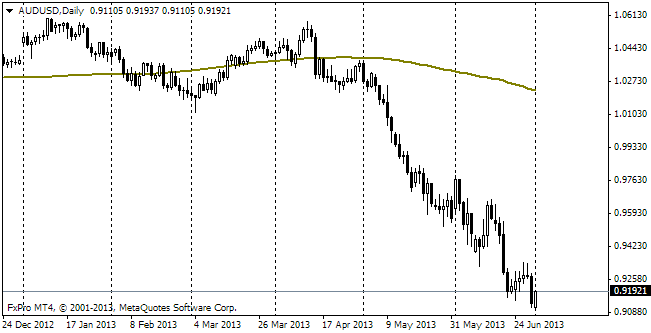EUR/usd
The single currency tested 1.2500 on Friday. This decline was caused by the perfect US employment statistics. The unemployment rate decreased from 6.1% to 5.9% and the number of jobs grew by 248K instead of the expected 210. Besides, the August statistics were revised up from 142 to 180. The average weekly hours has also slightly increased (from 34.5 to 34.6). But in the meantime, the average hourly earnings lost 1%, which in a way contradicts the classic situation with the tight employment market. It's also no good that the participation rate has again fallen. In September it made 62.7 against 62.8 in August. The current rate is the lowest since the late 1970s. Then the dynamics were growing as new jobs were created due to women, seeking work. Now despite the growing demand for workforce, the share of people of the retirement age is getting larger. Now some economists expect that the economic participation rate may shrink as some retirees will want to get back to their jobs or postpone their retirement. But it isn't happening yet, as we see. And it implies a bigger load on the US pension system with the following expansion of the budget deficit. In its turn, it reduces inflation risks in the economy and lowers the possibility of quicker tightening of the monetary policy (than under normal circumstances).
GBP/USD
The British pound tumbled down below 1.60 on the reaction to the US employment statistics. Partly the movement was supported by triggering of stop orders below the lows of September at 1.6070 (the moment of negative expectations from the referendum). But also we should take into account the delayed impulse from the British currency, whose weakness is explained by activity slowdown both in manufacture and services. Only the Construction PMI is growing, but can hardly be a guideline for the MPC as far as the policy tightening is concerned.

USD/JPY
On the tide of demand for the dollar after the favourable employment statistics bulls again tried to climb above 110. They haven't succeeded yet and the pair is consolidating near 109.80. It is not surprising that dollar-bulls want to have a rest after the stormy rally in August-September. But upon the whole, it doesn't lift the overall downward pressure from the yen because of the fundamental factors. Technically, the overbought status of the pair can deter growth in the coming days and weeks.

AUD/USD
Tomorrow the RBA holds a meeting on the monetary policy. Earlier we heard from observers that the housing boom was likely to make the Bank start tightening the monetary policy, which will be a burden for still weak other economic sectors. It could support the aussie in the short term, but would seriously reduce the potential for growth in the coming quarters and years. But now it seems that market participants more and more believe that the RBA will resort to others, non-monetary, methods to damp down the housing market. The guideline can be found in the policy of the RBNZ, which limits the volume of the high-risk mortgages. The non-monetary measures will make purchases of the AU dollar less attractive for speculators. Possibly, we'll learn about it tomorrow. If concerns about the RBA's intention to employ non-monetary measures are confirmed, it may cancel today's attempts of AUD to adjust after Friday's decline to the lows of 2010.
